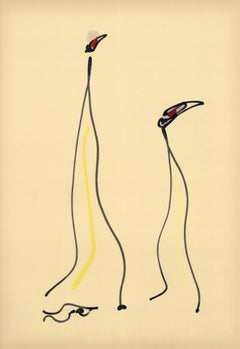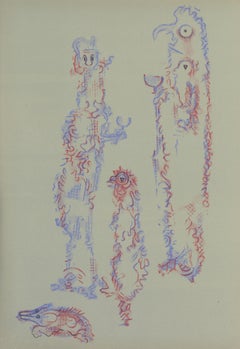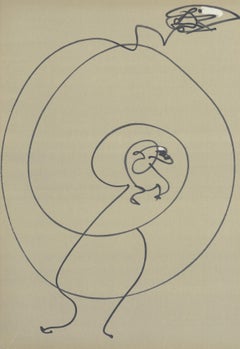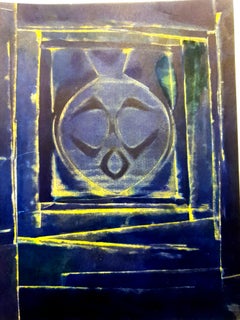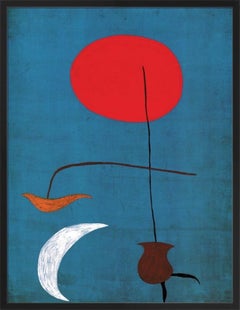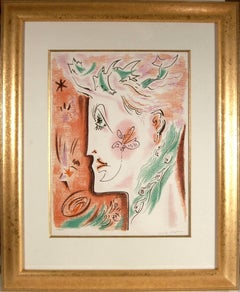(after) Max Ernst Art
to
1
5
2
7
5
1
1
Overall Height
to
Overall Width
to
5
2
1
1
1
1
1
1
1
1
1
1
1
1
1
1
7
2
4
1
7
6,909
3,240
2,514
1,217
6
1
Artist: (after) Max Ernst
"Les chiens ont soif" lithograph
By (after) Max Ernst
Located in Henderson, NV
Medium: lithograph (after the drawing). Printed by Mourlot for the deluxe limited edition portfolio "Les chiens ont soif", this is one of 250 impressions on BFK Rives wove paper (the...
Category
1960s (after) Max Ernst Art
Materials
Lithograph
pochoir
By (after) Max Ernst
Located in Henderson, NV
Medium: pochoir. Printed at the atelier of Daniel Jacomet in 1958 for the art revue XXe Siecle (issue number 10) published in Paris by San Lazzaro. Size: 12 3/8 x 9 1/2 inches (315 x...
Category
1950s Surrealist (after) Max Ernst Art
Materials
Lithograph
"Les chiens ont soif" lithograph
By (after) Max Ernst
Located in Henderson, NV
Medium: lithograph (after the drawing). Printed by Mourlot for the deluxe limited edition portfolio "Les chiens ont soif", this is one of 250 impressions on BFK Rives wove paper (the...
Category
1960s Surrealist (after) Max Ernst Art
Materials
Lithograph
"Les chiens ont soif" lithograph
By (after) Max Ernst
Located in Henderson, NV
Medium: lithograph (after the drawing). Printed by Mourlot for the deluxe limited edition portfolio "Les chiens ont soif", this is one of 250 impressions on BFK Rives wove paper (the...
Category
1960s Surrealist (after) Max Ernst Art
Materials
Lithograph
Playing Cards - Lithograph poster for "Le Surrealisme" by Max ERNST (Mourlot)
By (after) Max Ernst
Located in Paris, FR
Exhibition poster after Max ERNST featuring an image of playing cards
HIgh-quality lithograph printed in Mourlot workshop in 1964
Created for the exhibition "Le Surréalisme, Sources...
Category
1960s Surrealist (after) Max Ernst Art
Materials
Lithograph
(after) Max Ernst - Blue Bird - Stencil
By (after) Max Ernst
Located in Collonge Bellerive, Geneve, CH
Max Ernst (after) - Blue Bird - Stencil
Published in the deluxe art review, XXe Siecle, 1958
Dimensions: 32 x 25 cm
Publisher: G. di San Lazzaro.
Max Ernst was born in Bruhl, a place near Cologne, in Germany. He was raised in a strict Catholic family, and both of his parents were disciplinarians who were dedicated to training their children into God-fearing and talented individuals. Although his father was deaf, Ernst learned so much from him, particularly when it comes to painting. In fact, much of his early years were lived under the inspiration of his father who was also a teacher. He was the one who introduced painting to Ernst at an early age.
In 1914, Ernst attended the University of Bonn where he studied philosophy. However, he eventually dropped out of school because he was more interested in the arts. He claimed that his primary sources of interest included anything that had something to do with painting. Moreover, he became fascinated with psychology, among other subjects in school.
Primarily, Ernst's love for painting was the main reason why he became deeply interested with this craft and decided to pursue it later on in his life. During his early years, he became familiar with the works of some of the greatest artists of all time including Claude Monet, Paul Cezanne and Vincent van Gogh. He was also drawn to themes such as fantasy and dream imagery, which were among the common subjects of the works of Giorgio de Chirico.
During World War I, Ernst was forced to join the German Army, and he became a part of the artillery division that exposed him greatly to the drama of warfare. A soldier in the War, Ernst emerged deeply traumatized and highly critical of western culture. These charged sentiments directly fed into his vision of the modern world as irrational, an idea that became the basis of his artwork. Ernst's artistic vision, along with his humor and verve come through strongly in his Dada and Surrealists works; Ernst was a pioneer of both movements.
It was Ernst's memories of the war and his childhood that helps him create absurd, yet interesting scenes in his artworks. Soon, he took his passion for the arts seriously when he returned to Germany after the war. With Jean Arp, a poet and artist, Ernst formed a group for artists in Cologne. He also developed a close relationship with fellow artists in Paris who propagated Avant-Garde artworks.
In 1919, Ernst started creating some of his first collages, where he made use of various materials including illustrated catalogs and some manuals that produced a somewhat futuristic image. His unique masterpieces allowed Ernst to create his very own world of dreams and fantasy, which eventually helped heal his personal issues and trauma. In addition to painting and creating collages, Ernst also edited some journals. He also made a few sculptures that were rather queer in appearance.
In 1920s, influenced by the writings of psychologist Sigmund Freud, the literary, intellectual, and artistic movement called Surrealism sought a revolution against the constraints of the rational mind; and by extension, they saw the rules of a society as oppressive. Surrealism also embraces a Marxist ideology that demands an orthodox approach to history as a product of the material interaction of collective interests, and many renown Surrealism artists later on became 20th century Counterculture symbols such as Marxist Che Guevara. In 1922 Ernst moved to Paris, where the surrealists were gathering around Andre Breton. In 1923 Ernst finished Men Shall Know Nothing of This, known as the first Surrealist painting. Ernst was one of the first artists who apply The Interpretation of Dreams by Freud to investigate his deep psyche in order to explore the source of his own creativity. While turning inwards unto himself, Ernst was also tapping into the universal unconscious with its common dream imagery.
Despite his strange styles, Ernst gained quite a reputation that earned him some followers throughout his life. He even helped shape the trend of American art during the mid-century, thanks to his brilliant and extraordinary ideas that were unlike those of other artists during his time. Ernst also became friends with Peggy Guggenheim, which inspired him to develop close ties with the abstract expressionists.
When Ernst lived in Sedona, he became deeply fascinated with the Southwest Native American navajo art. In fact, the technique used in this artwork inspired him and paved the way for him to create paintings that depicted this style. Thus, Ernst became a main figure of this art technique, including the rituals and spiritual traditions included in this form of art. Pollock, aside from the other younger generations of abstract expressionists, was also inspired by sand painting of the Southwest...
Category
1950s Surrealist (after) Max Ernst Art
Materials
Stencil
Le Vent Se Repose Jaune-Poster, New York Graphic Society. Printed in Italy
By (after) Max Ernst
Located in Clinton Township, MI
1982 New York Graphic Society Ltd. Printed in Italy. The poster measures 30 x 25 inches and is unframed. The piece is in Good/Fair Condition-there is a tear on the bottom-left edge a...
Category
1980s (after) Max Ernst Art
Materials
Lithograph
Related Items
Joan Miró, Design for a Tapestry
By Joan Miró
Located in Manchester, GB
Joan Miró, Design for a Tapestry
Lithograph
62 x 82 cm
Artwork is framed in a sustainably sourced gallery black box frame with acrylic glazing.
Design for a Tapestry' by Joan M...
Category
Late 20th Century Surrealist (after) Max Ernst Art
Materials
Lithograph
Surrealist Woman
By André Masson
Located in San Francisco, CA
Artist: Andre Masson (French)
Title: Surrealist Woman
Year: 1970
Medium: Color lithograph
Edition: Numbered 146/200 in pencil
Image size: 24 x 18.5 inches
Signature: Hand signed in...
Category
Mid-20th Century Surrealist (after) Max Ernst Art
Materials
Lithograph
Sol y Dali - Rare Vintage Lithograph Poster - Mourlot 1967 (Field #67-1)
By (after) Salvador Dali
Located in Paris, FR
Salvador Dali
Sol y Dali
Vintage lithographic poster (Mourlot workshop)
Printed signature in the plate
Edited in 1967 by Jean Schneider
On paper 78 x 54 cm...
Category
1960s Surrealist (after) Max Ernst Art
Materials
Lithograph
Beati Pauperes...Beati Mites...Beati - Lithograph - 1964
By Salvador Dalí
Located in Roma, IT
Beati pauperes...beati mites...beati is an artwork realized in 1964.
It is part of Biblia Sacra vulgatæ editionis published by Rizzoli-Mediolani between 1967 and 1969.
Color lithog...
Category
1970s Surrealist (after) Max Ernst Art
Materials
Lithograph
René Magritte - LE CHEF D'OEUVRE OU... Limited Surrealism French Contemporary
By (after) René Magritte
Located in Madrid, Madrid
René Magritte - LE CHEF D'OEUVRE OU LES MYSTÈRES DE L'HORIZON, 1965
Date of creation: 2010
Medium: Lithograph on BFK Rives Paper
Edition number: 131/275
Size: 60 x 45 cm
Condition: N...
Category
Mid-20th Century Surrealist (after) Max Ernst Art
Materials
Lithograph
Free Shipping
H 17.72 in W 23.63 in
Colour Lithograph 'La Triple Roue ll' 1981
By Joan Miró
Located in Toronto, CA
'La Triple Roue ll'
Limited edition colour lithograph on Arches paper from Joan Míro's final series of fifteen lithographs, 'Allegro Vivace' 1981. The series is known for its bold fo...
Category
Late 20th Century Surrealist (after) Max Ernst Art
Materials
Lithograph
Surrealist Salvador Dali Large Pochoir Etching Drypoint Lithograph Chariot Rider
By Salvador Dalí
Located in Surfside, FL
Salvador Dalí (1904-1989) – Spanish painter, graphic artist and sculptor.
Drypoint with etching and pochoir on Japon paper
"Elijah and the Chariot," 1975, (Horse and rider)
from the "Our Historical Heritage" suite.
Pencil signed along the lower right and numbered 53/250 along the lower left.
Literature: Field 75-4 J
Framed; Height: 29 in x width: 35 in. Mat opening 19.5 X 25.5.
The Spanish artist’s extensive oeuvre not only includes watercolors, drawings and sculptures but also tapestries; here a fine example from the limited edition ‘The Twelve Tribes of Israel’
The tapestry was created after an etching by Salvador Dalí from 1973 with the title ‘The Tribe of Judah’, which the artist created as part of a suite to mark the 25th anniversary of the State of Israel, and in which he represented the twelve tribes of Israel. This vintage French tapestry is an impeccable textile re-creation of a rare Dali etching. This is a flat weave Aubusson style tapisserie. The edition size was 500. The tapestry is inscribed with woven ‘Salvador Dalí’ lower right
Genre: Surrealism
Subject: people, architecture rendering
Medium: textile
Salvador Dali (Spanish, 1904-1989)
Salvador Dali is considered as the greatest original artist of the surrealist art movement and one of the greatest masters of art of the twentieth century.
Dali began to study art at the Royal Academy of Art in Madrid. He was expelled twice and never took the final examinations. His opinion was that he was more qualified than those who should have examined him.
In 1928 Dali went to Paris where he met the Spanish painters Pablo Picasso and Joan Miro. He established himself as the principal figure of a group of surrealist artists grouped around Andre Breton, who was something like the theoretical "schoolmaster" of surrealism. Years later Breton turned away from Dali accusing him of support of fascism, excessive self-presentation and financial greediness.
By 1929 Dali had found his personal style that should make him famous - the world of the unconscious that is recalled during our dreams. The surrealist theory is based on the theories of the psychologist Dr. Sigmund Freud. Recurring images of burning giraffes and melting watches became the artist's surrealist trademarks. Along with Rene Magritte his is considered the greatest of the Surrealists. His great craftsmanship allowed him to execute his paintings in a nearly photo realistic style. No wonder that the artist was a great admirer of the vintage Italian Renaissance painter Raphael. Meeting Gala was the most important event in the artist's life and decisive for his future career. She was a Russian immigrant and ten years older than Dali. When he met her, she was married to Paul Eluard. In 1933 Salvador Dali had his first one-man show in New York. One year later he visited the U.S. for the first time supported by a loan of US$500 from Pablo Picasso. To evade World War II, Dali chose the U.S.A. as his permanent residence in 1940. He had a series of spectacular exhibitions, among others a great retrospective at the Museum of Modern Art in New York. He has worked in paining, sculpture, tapestry, Daum glass and prints.
Dali became the darling of the American High Society. Celebrities like Jack Warner or Helena Rubinstein gave him commissions for portraits. His artworks became a popular trademark and besides painting he pursued other activities - jewelry and dated clothing designs for Coco Chanel or film making with Alfred Hitchcock.
In 1948 Dali and Gala returned to Europe, spending most of their time either in their residence in Ligate/Spain or in Paris/France or in New York. Dali developed a lively interest in science, religion and history. He integrated things into his art that he had picked up from popular science...
Category
1970s Surrealist (after) Max Ernst Art
Materials
Drypoint, Etching, Lithograph
Joan Miró - "Original Lithography IX" - color lithography - Cramer 160
By Joan Miró
Located in Winterswijk, NL
Litografo (Volume I) Italian edition from 1972.
Catalogue of works: Cramer 160.
Slight book fold in the centre of the paper.
Miró's development of a new pictorial language led to a consistent restriction to the primary colours black, green, yellow, blue and red, which he implemented in the series of paintings "Constellations" (1940/41) with lines, spots and areas of colour.
Like Pablo Picasso and Franz Marc, Miró also worked with graphics and primarily produced etchings and lithographs. Produced in large editions, the artist believed that everyone should be able to afford a print by Miró...
Category
20th Century Surrealist (after) Max Ernst Art
Materials
Lithograph
Free Shipping
H 13.19 in W 20.08 in
After Pablo Picasso - Don Quixote - Lithograph
By (after) Pablo Picasso
Located in Collonge Bellerive, Geneve, CH
After PABLO PICASSO (1881-1973)
Don Quixote
1955
Dimensions: 65 x 50 cm
Printed signature and date
Edition Succession Picasso, Paris (posthumous reproductive edition)
Editions de la ...
Category
1950s Surrealist (after) Max Ernst Art
Materials
Lithograph
St Georges et le Dragon, Surrealist Etching by Salvador Dali 1974
By Salvador Dalí
Located in Long Island City, NY
Salvador Dali was a Spanish painter, printmaker, and sculptor heralded as the father of surrealism. This piece features the fabled story of Saint George gallantly slaying a dragon. T...
Category
1960s Surrealist (after) Max Ernst Art
Materials
Stencil, Etching
RECEIVING HAND Signed Lithograph, Fantastic Realism, Stone, Healing Art
By De Es Schwertberger
Located in Union City, NJ
RECEIVING HAND is a hand drawn original lithograph printed using hand lithography techniques on archival Arches printmaking paper 100% acid free. RECEIVING HAND a finely detailed han...
Category
1970s Surrealist (after) Max Ernst Art
Materials
Lithograph
No Reserve
H 29.5 in W 21.75 in
Esther Accuses Haman- Lithograph by Marc Chagall - 1960s
By Marc Chagall
Located in Roma, IT
Esther Accuses Haman is an artwork realized by March Chagall, 1960s.
Lithograph on brown-toned paper, no signature.
Lithograph on both sheets.
Edition of 6500 unsigned lithographs...
Category
1960s Surrealist (after) Max Ernst Art
Materials
Lithograph
No Reserve
H 13.78 in W 10.24 in D 0.04 in
(after) Max Ernst art for sale on 1stDibs.
Find a wide variety of authentic (after) Max Ernst art available for sale on 1stDibs. If you’re browsing the collection of art to introduce a pop of color in a neutral corner of your living room or bedroom, you can find work that includes elements of blue and other colors. You can also browse by medium to find art by (after) Max Ernst in lithograph, stencil and more. Much of the original work by this artist or collective was created during the 20th century and is mostly associated with the Surrealist style. Not every interior allows for large (after) Max Ernst art, so small editions measuring 10 inches across are available. (after) Max Ernst art prices can differ depending upon medium, time period and other attributes. On 1stDibs, the price for these items starts at $150 and tops out at $776, while the average work can sell for $225.
Questions About (after) Max Ernst Art
- Where did Max Ernst live?1 Answer1stDibs ExpertApril 26, 2024Max Ernst lived in several places during his life. He was born in Brühl, Germany, in 1881 and later moved to Bonn to attend the university located there. Then he settled in Cologne, not far from his birthplace. In 1922, Ernst moved to France, where he soon became affiliated with Surrealism, the avant-garde art movement taking shape in Paris. Alongside Man Ray, Joan Miró and others, Ernst was among the first visual artists to experiment with imagery and techniques associated with Surrealism. When Germany occupied France during World War II, Ernst escaped to America with the help of patron and collector Peggy Guggenheim, whom he married in 1941. While living in New York, Ernst's work and techniques proved instrumental in inspiring the early development of Abstract Expressionism. He later moved to Sedona, Arizona, where he lived with his fourth wife, Dorothea Tanning, a fellow Surrealist and prolific visual artist and poet. While Ernst and Tanning are largely responsible for Sedona's reputation as an artist colony, they relocated to France in the 1950s and remained there until Ernst's death in Paris in 1976. On 1stDibs, shop a collection of Max Ernst art.
- 1stDibs ExpertMarch 13, 2024You can see Max Ernst paintings in many places around the world. The Max Ernst Museum Brühl des LVR in Brühl, Germany, is home to one of the largest exhibitions of his work. Other museums that have Max Ernst paintings in their permanent collections include the Museum of Modern Art in New York, New York; the San Francisco Museum of Modern Art in San Francisco, California; the Art Institute of Chicago in Chicago, Illinois and the Detroit Institute of Arts in Detroit, Michigan. Explore a range of Max Ernst art on 1stDibs.
- Where is Peter Max from?1 Answer1stDibs ExpertMarch 22, 2022Peter Max is originally from Berlin, Germany. During World War II, his family lived in Shanghai, China. As an adult, the artist lived in Haifa, Israel; Paris, France; and New York, New York. You can shop a range of Peter Max art on 1stDibs.
- Who is Peter Max?1 Answer1stDibs ExpertMarch 22, 2022Peter Max is an artist known for creating colorful pop art compositions. He was born on October 19, 1937, in Berlin, Germany, and eventually made Brooklyn, New York his home. Some of his most famous works include Without Borders, Blushing Beauty, Better World and Love. Shop a range of Peter Max art on 1stDibs.
- What cameras did Ernst Haas use?1 Answer1stDibs ExpertMarch 22, 2022Ernst Haas used multiple cameras over the course of his career. Early on, he shot with a Rolleiflex made by the German company Rollei GmbH & Co. Toward the end of the 1940s, he began using a more portable 35mm Leica rangefinder. On 1stDibs, shop a range of Ernst Haas photographic art.
- What did Max Bill create?1 Answer1stDibs ExpertMarch 22, 2022Max Bill created many types of items during his career. The Swiss artist worked as a graphic designer creating many compositions indicative of the modern style of the time. In addition, he was an industrial designer who made a variety of decorative objects and furnishings. He is best known for the clocks produced for Junghans, the Ulmer Hocker stool, the Atomic chandelier and the Tulip floor lamp. On 1stDibs, shop a variety of Max Bill art, furniture and decorative objects.
- What is Max Beckmann known for?1 Answer1stDibs ExpertMarch 22, 2022Max Beckmann is known for creating bold, highly emotional paintings, sculptures and prints that commented on events that rocked the world during the early 20th century. Some of his most famous works include The Night, Quappi in Pink Jumper, Paris Society and Birds' Hell. Find a variety of Max Beckmann art on 1stDibs.
- Where was Peter Max born?1 Answer1stDibs ExpertFebruary 13, 2024Peter Max was born in Berlin, Germany, in 1937. However, he spent the first part of his childhood in Shanghai, China, after his parents emigrated from Germany to flee the Nazis. While there, Max developed his deep interest in American pop culture, namely comic books, jazz and cinema. Shop a collection of Peter Max art on 1stDibs.
- Is Max Beckmann still alive?1 Answer1stDibs ExpertApril 5, 2022No, sadly Max Beckmann is no longer alive. Max Beckmann created a legacy as a painter, sculptor and writer, and was made famous by his bold symbolic work on tragic war-time events. He died in 1950. You can shop a selection of Max Beckman pieces from some of the world’s top art dealers on 1stDibs.
- Is Peter Max still painting?1 Answer1stDibs ExpertMarch 22, 2022No, Peter Max is no longer painting. Reportedly, he stopped painting in 2015 due to health problems. Some of the artist's most famous works include Without Borders, Blushing Beauty, Better World, Deco Lady and Flag with Heart. Find a variety of Peter Max art on 1stDibs.
- What media did Peter Max use?1 Answer1stDibs ExpertMarch 22, 2022Peter Max uses a variety of media to produce his colorful compositions. Many of his pieces are paintings. He also produces collages, prints, sculptures, digital art and films. During the course of his career, he received commissions to create posters for the Super Bowl, the Grammys and the U.S. Open. Shop a collection of Peter Max art on 1stDibs.
- 1stDibs ExpertApril 5, 2022The kind of art that is associated with Peter Max is colorful and bold — the psychedelic Pop art that characterizes the majority of the German-born American artist's paintings and prints owes to an interest in comic books, jazz and films that he developed in his youth. Max's work is also informed by his experience with synesthesia, a sensory condition that causes him to see music and hear color. Find a collection of original Peter Max art on 1stDibs.
- 1stDibs ExpertMarch 22, 2022Peter Max is best known for producing vibrant, bold paintings that draw inspiration from psychedelic and pop art. His famous works like Without Borders, Blushing Beauty, Better World and Love are popular contemporary wall art and are often sold as prints and posters. Shop a selection of Peter Max art on 1stDibs.
- 1stDibs ExpertMarch 22, 2022Most historians classify Max Beckmann as an Expressionist artist because of the highly emotional nature of his paintings, prints and sculptures. However, Beckmann did not embrace the label during his life. Find a selection of Max Beckmann art on 1stDibs.
- 1stDibs ExpertFebruary 22, 2021How much a Peter Max painting is worth will be determined by its condition, the presence of a signature, size and other factors. Born Peter Max Finkelstein in Berlin in 1937, psychedelic Pop art icon Peter Max spent the first part of his childhood in Shanghai after his parents emigrated from Germany to flee the Nazis. While there, Max developed a deep interest in American pop culture — namely comic books, jazz and cinema — that would inform his bold and graphic paintings. His prints can be found for less than approximately $1,000 but his paintings have sold for between $10,000 and $20,000 over the years. Find original Peter Max paintings on 1stDibs.
- 1stDibs ExpertApril 5, 2022Peter Max's connection to the Statue of Liberty is that he created multiple paintings of the famous landmark. He made the first one for America's Bicentennial on July 4, 1976. You can shop a range of Peter Max art on 1stDibs.
